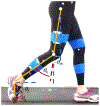Analysis of Continuously Varying Kinematics for Prosthetic Leg Control Applications
- PMID: 33320814
- PMCID: PMC7920935
- DOI: 10.1109/TNSRE.2020.3045003
Analysis of Continuously Varying Kinematics for Prosthetic Leg Control Applications
Abstract
Powered prosthetic legs can improve the quality of life for people with transfemoral amputations by providing net positive work at the knee and ankle, reducing the effort required from the wearer, and making more tasks possible. However, the controllers for these devices use finite state machines that limit their use to a small set of pre-defined tasks that require many hours of tuning for each user. In previous work, we demonstrated that a continuous parameterization of joint kinematics over walking speeds and inclines provides more accurate predictions of reference kinematics for control than a finite state machine. However, our previous work did not account for measurement errors in gait phase, walking speed, and ground incline, nor subject-specific differences in reference kinematics, which occur in practice. In this work, we conduct a pilot experiment to characterize the accuracy of speed and incline measurements using sensors onboard our prototype prosthetic leg and simulate phase measurements on ten able-bodied subjects using archived motion capture data. Our analysis shows that given demonstrated accuracy for speed, incline, and phase estimation, a continuous parameterization provides statistically significantly better predictions of knee and ankle kinematics than a comparable finite state machine, but both methods' primary source of predictive error is subject deviation from average kinematics.
Figures






Similar articles
-
Modeling the Transitional Kinematics Between Variable-Incline Walking and Stair Climbing.IEEE Trans Med Robot Bionics. 2022 Aug;4(3):840-851. doi: 10.1109/tmrb.2022.3185405. Epub 2022 Jun 22. IEEE Trans Med Robot Bionics. 2022. PMID: 35991942 Free PMC article.
-
Modeling the Kinematics of Human Locomotion Over Continuously Varying Speeds and Inclines.IEEE Trans Neural Syst Rehabil Eng. 2018 Dec;26(12):2342-2350. doi: 10.1109/TNSRE.2018.2879570. Epub 2018 Nov 5. IEEE Trans Neural Syst Rehabil Eng. 2018. PMID: 30403633 Free PMC article.
-
Novel velocity estimation for symmetric and asymmetric self-paced treadmill training.J Neuroeng Rehabil. 2021 Feb 5;18(1):27. doi: 10.1186/s12984-021-00825-3. J Neuroeng Rehabil. 2021. PMID: 33546729 Free PMC article.
-
Piecewise and unified phase variables in the control of a powered prosthetic leg.IEEE Int Conf Rehabil Robot. 2017 Jul;2017:1425-1430. doi: 10.1109/ICORR.2017.8009448. IEEE Int Conf Rehabil Robot. 2017. PMID: 28814020 Free PMC article.
-
Contributions to the understanding of gait control.Dan Med J. 2014 Apr;61(4):B4823. Dan Med J. 2014. PMID: 24814597 Review.
Cited by
-
Lower-limb kinematics and kinetics during continuously varying human locomotion.Sci Data. 2021 Oct 28;8(1):282. doi: 10.1038/s41597-021-01057-9. Sci Data. 2021. PMID: 34711856 Free PMC article.
-
Predicting Individualized Joint Kinematics Over Continuous Variations of Walking, Running, and Stair Climbing.IEEE Open J Eng Med Biol. 2023 Jan 5;3:211-217. doi: 10.1109/OJEMB.2023.3234431. eCollection 2022. IEEE Open J Eng Med Biol. 2023. PMID: 36819935 Free PMC article.
-
Data-Driven Variable Impedance Control of a Powered Knee-Ankle Prosthesis for Adaptive Speed and Incline Walking.IEEE Trans Robot. 2023 Jun;39(3):2151-2169. doi: 10.1109/tro.2022.3226887. Epub 2023 Jan 13. IEEE Trans Robot. 2023. PMID: 37304232 Free PMC article.
-
Phase-Variable Control of a Powered Knee-Ankle Prosthesis over Continuously Varying Speeds and Inclines.Rep U S. 2021 Sep-Oct;2021:6182-6189. doi: 10.1109/iros51168.2021.9636180. Epub 2021 Dec 16. Rep U S. 2021. PMID: 35251752 Free PMC article.
-
Modeling the Transitional Kinematics Between Variable-Incline Walking and Stair Climbing.IEEE Trans Med Robot Bionics. 2022 Aug;4(3):840-851. doi: 10.1109/tmrb.2022.3185405. Epub 2022 Jun 22. IEEE Trans Med Robot Bionics. 2022. PMID: 35991942 Free PMC article.
References
-
- Michael JW and Bowker JH, Atlas of amputations and limb deficiencies: surgical, prosthetic, and rehabilitation principles. American Academy of Orthopaedic Surgeons, 2004.
-
- Kaufman KR, Levine JA, Brey R, Iverson B, McCrady S, Padgett D, and Joyner MJ, “Gait and balance of transfemoral amputees using passive mechanical and microprocessor-controlled prosthetic knees,” Gait & posture, vol. 26, no. 4, pp. 489–493, 2007. - PubMed
-
- Sup F, Varol HA, and Goldfarb M, “Upslope walking with a powered knee and ankle prosthesis: initial results with an amputee subject,” IEEE Trans. Neural Syst. Rehabil. Eng, vol. 19, no. 1, pp. 71–78, 2011. - PubMed
-
- Lawson BE, Varol HA, Huff A, Erdemir E, and Goldfarb M, “Control of stair ascent and descent with a powered transfemoral prosthesis,” IEEE Trans. Neural Syst. Rehabil. Eng, vol. 21, no. 3, pp. 466–473, 2012. - PubMed
-
- Shultz AH, Lawson BE, and Goldfarb M, “Running with a powered knee and ankle prosthesis,” IEEE Trans. Neural Syst. Rehabil. Eng, vol. 23, no. 3, pp. 403–412, 2015. - PubMed
Publication types
MeSH terms
Grants and funding
LinkOut - more resources
Full Text Sources
Other Literature Sources
Medical

